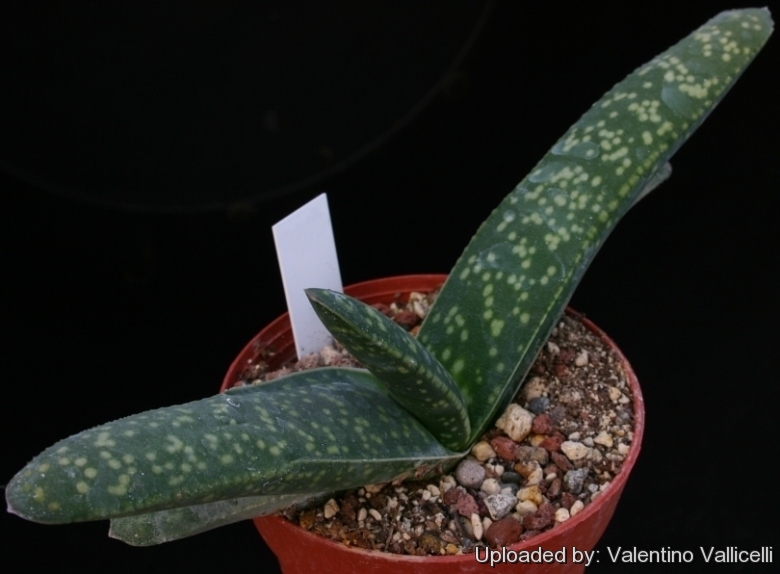Accepted Scientific Name: Gasteria pillansii Kensit
Trans. Roy. Soc. South Africa 1: 163 1910.

Gasteria neliana Photo by: Valentino Vallicelli
Origin and Habitat: South Africa, Northern Cape it is the only Gasteria of Namaqualand.
Habitat: It grows on quartz veins in succulent shrubland in close proximity to the Adromischus and similarly camouflaged.
Synonyms:
See all synonyms of Gasteria pillansii
Common Names include:
ENGLISH: Cattle Tongue, Ox-tongue, Mother-in-law's tongue, Lawyer's tongue, Cow-tongue cactus
AFRIKAANS (Afrikaans): Namaqua-beestong
Description: Gasteria nelianaSN|17327]]SN|17328]], once considered a separate species, is now regarded as a form of Gasteria pillansiiSN|17328]]SN|17327]] with thick, fleshy, heavily spotted tongue-like leaves. It proliferate from subterraneous stolons and forms large clumps.
Rosettes: Acaulescent with 8-12 decumbent to erect leaves, 5-20 cm tall and 6-40 cm wide.
Leaves: Up to 18(-20) cm long, 4-4,5 cm cm wide, lorate, pointed at the tip, both surfaces slightly convex, emerald green with whitish green spots often forming transverse rows. Margins minutely toothed.
Flowers: 3,5 cm long.
Subspecies, varieties, forms and cultivars of plants belonging to the Gasteria pillansii group
 Gasteria neliana Poelln.: sometimes considered a distinct species, it has thick, fleshy, heavily spotted leaves. Distribution: It is the only Gasteria of Namaqualand (Northern Cape).
Gasteria neliana Poelln.: sometimes considered a distinct species, it has thick, fleshy, heavily spotted leaves. Distribution: It is the only Gasteria of Namaqualand (Northern Cape).- Gasteria pillansii Kensit: has heavily spotted tongue-like leaves. It proliferate from subterraneous stolons and forms clumps up to 1 m wide. Distribution: Western Cape, Namaqualand and southern Nambia.
 Gasteria pillansii var. ernesti-ruschii (Dinter & Poelln.) van Jaarsv.: small forms with leaves smaller than 70 mm. Distribution: near the Port Nolloth coast to southern Namibia.
Gasteria pillansii var. ernesti-ruschii (Dinter & Poelln.) van Jaarsv.: small forms with leaves smaller than 70 mm. Distribution: near the Port Nolloth coast to southern Namibia.
Bibliography: Major references and further lectures
1) Ernst J. Van Jaarsveld, Ellaphie Ward-Hilhorst “Gasterias of South Africa: a new revision of a major succulent group” National Botanical Institute (South Africa)
2) Van Jaarsveld, E.J. 1994. “Gasterias of South Africa” Fernwood Press, Cape Town
3) Urs Eggli “Illustrated Handbook of Succulent Plants: Monocotyledons” Springer, 2001
4) Charles L. Scott “The genus Haworthia (Liliaceae): a taxonomic revision” Aloe Books, 1985
5) James Cullen, Sabina G. Knees, H. Suzanne Cubey “The European Garden Flora Flowering Plants: A Manual for the Identification of Plants Cultivated in Europe, Both Out-of-Doors and Under Glass” Cambridge University Press, 11/Aug/2011
6) Bolus, H. & Kensit, Louisa, 1909. "Contributions to the African Flora: Gasteria pillansii., Kensit, n. sp." Transactions of the Royal Society of South Africa 1: 163.
7) Kennedy, R.F. 1967. "Cataloque of pictures in the Africana museum" Vol 2, 307-738. Africana Museum , Johannnesburg.
8) Von Poellnitz, K. & Dinter, K. 1938. "Die erste Gasteria-art aus Sudwestafrika. Gasteria ernesti-ruschii Dinter et von Poellnitz spec. nov." Kakteen und Andere Sukkulenten, 63: 239.
Cultivation and Propagation: It is of easy culture and can grow on window sills, verandas and in miniature succulent gardens where it is happy to share its habitat with other smaller succulent plants, or in outdoor rockeries.
Growth rate: It is a relatively fast-growing plant that offsets freely to form small clusters quickly.
Soil: It is tolerant of a wide range of soils and habitats, but prefers a very porous potting mix to increase drainage. A non-acid soil is ideal. You can grow a plant in a 10-15 cm pot for years and have perfectly happy plants. For best results, use a shallow pot.
Exposure: Need light shade to shade, but will take full sun part of the day. (with some sun exposure the leaf develops a nice reddish tint and remain compact) During the hot summer months, the soil should be kept moist but not overly wet.
Watering: During the hot summer months, the soil should be kept moist but not overly wet. During the winter months, water only when the soil becomes completely dry. Wet soil quickly causes root and stem rot, especially during chilly winter months. No water should ever be allowed to stand around the roots. Low ambient humidity is always needed.
Feeding: The plants are fertilized only once during the growing season with a balanced fertilizer diluted to ½ the recommended strength.
Hardiness: During the winter months, water only when the soil becomes completely dry. Frost hardy to -1°C (Or less). USDA Zones 9b-11.
Pest and diseases: Rot is only a minor problem with Gasteria if the plants are watered and “aired” correctly. If they are not, fungicides won't help all that much. Incorrect watering, poor drainage or too much shade can lead to attack by pests and diseases. Care must be given in watering, keeping them warm and wet while growing, and cooler and dry when dormant.
Remarks: Gasterias are best planted in a shaded and airy part of the greenhouse, and not too close to the glass roof or sides of the house as the plants can overheat during hot spells.
Propagation: Gasterias are easily propagated by the removal of offshoots or by leaf cuttings in spring or summer. To propagate by leaf cuttings, remove a leaf and let it lie for about one month, giving the wound time to heal. Then lay the leaf on its side with the basal part buried in the soil. This leaf should root within a month or two, and small plants will form at the leaf base. They can also grown from seed.










